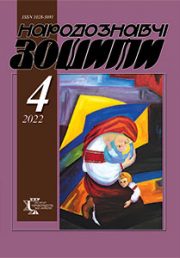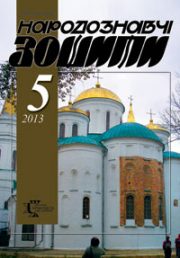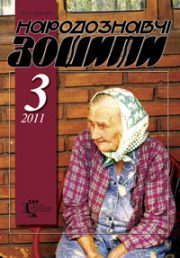The Ethnology Notebooks. 2024. № 4 (178), 945—954
UDK 391(=161.2):746.3]:930.85](477)”20″
DOI https://doi.org/10.15407/nz2024.04.945
«EMBROIDERED REVIVAL» AS A PHENOMENON OF NATIONAL UNION OF UKRAINIANS IN THE XXI CENTURY
PONOMAR Liudmyla
- ORCID ID: https://orcid.org/0000-0003-1725-9230
- Candidate of Historical Sciences,
- Senior Research Fellow of the Department of
- «Ukrainian Ethnological Center»,
- M. Rylskyi Institute of Art Studies, Folkloristics and Ethnology
- of the National Academy of Sciences of Ukraine,
- 4, M. Hrushevskyi Street, 01001, Kyiv, Ukraine,
- Contacts: e-mail: ponomarl@ukr.net
SKLIAR Volodymyr
- ORCID ID: https://orcid.org/0000-0003-0020-5973
- Doctor of Historical Sciences, Professor,
- Chief Research Fellow of the Department of «Ukrainian Ethnological Center»,
- M. Rylskyi Institute of Art Studies, Folkloristics and Ethnology
- of the National Academy of Sciences of Ukraine,
- 4 M. Hrushevskyi Street, 01001, Kyiv, Ukraine,
- Contacts: e-mail: sklyar_vm@ukr.net
Abstract. In the context of russia’s aggression against Ukraine, aimed at destroying the Ukrainian state and Ukrainians as a separate nation (its russification), it is extremely important for Ukrainians to understand their own national identity and internal unity. An important component of this process is the revival of Ukrainian traditional culture, including interest in traditional Ukrainian clothing. Therefore, it is no coincidence that at the beginning of the XXI century, Ukrainian embroidery became a vivid symbol of Ukrainian identity. This determines the relevance of the study. The purpose of the article is to establish the significance of Ukrainian embroidery as an important factor in the formation of Ukrainian identity in the early XXI century. The object of the research is traditional Ukrainian clothing as a component of Ukrainian identity and the subject of research is Ukrainian embroidery as a vivid phenomenon of national union of Ukrainians in the early XXI century. The methodological basis of the scientific research is the integrated use of general scientific methods (analysis and synthesis), as well as special historical methods (historical-comparative, historical-structural and historical-typological). The source base of the research on the revival of Ukrainian folk clothes, folk style in fashion is formed by the study of Internet-resources. The results of the study proved that traditional Ukrainian clothing has become an expression of the process of growing interest in folk culture as a marker of national identity and during the Revolution of Dignity, the embroidered shirt became an expression of unity and resistance on a national scale. It has been established that in the context of open russian aggression since 2022, Ukrainian embroidery has become even more popular and has become a unique phenomenon of national union of Ukrainians not only in Ukraine, but also in all countries where they have found themselves as displaced persons.
Keywords: Ukraine, Ukrainian embroidered shirt, Ukrainian national identity and national union, Ukrainian traditional culture, Ukrainian traditional dress, symbol of Ukrainianness, early XXI century.
Received 29.06.2024
REFERENCES
- Nykorak, O. (2004). Ukrainian folk fabric of the 19th—20th centuries. Typology, localization, artistic features. Interior fabrics (based on materials from the western regions of Ukraine) (Part I). Lviv: Institute of Ethnology of the National Academy of Sciences of Ukraine [in Ukrainian].
- Oliynyk, M. (2017). Ukrainian clothing in the system of urban culture of Kyiv (second half of the 19th — beginning of the 21st century). Kyiv: M. Rylskyi Institute of Art Studies, Folkloristics and Ethnology of the National Academy of Sciences of Ukraine [in Ukrainian].
- Syvash, I. (2017). National clothing as a factor of ethnoculture in the context of Ukrainian ethnodesign. Art History Notes, 31, 228—236 [in Ukrainian].
- Matyukhina, O. National style in clothing as an expression of national self-awareness. Native fashion. Traditional and modern Ukrainian clothing for youth and nobility. 18.01.2009. Retrieved from: http://www.ridnamoda.com.ua/?p=598 (Last accessed: 26.05.2014) [in Ukrainian].
- Amulets of the Ukrainian nation. Ukrainian embroidery (Issue 8). Retrieved from: https://nibu.kyiv.ua/exhibitions/556/ (Last accessed: 18.05.2020) [in Ukrainian].
- Hutsalo, A. Yevhen Hutsalo. Where does the road run? Video film. Kyiv: Studio VIATEL. Youtube. 12.12.2018. Retrieved from: https://www.youtube.com/watch?v=7JYPHzfu1zs (Last accessed: 08.04.2024) [in Ukrainian].
- Sklyar, V. (2008). Ethnic composition of the population of Ukraine 1959—1989: ethnolinguistic consequences of russification. Kyiv: «Prosvita» Publishing Center [in Ukrainian].
- Orel, L. (1987). For folk motives. Beauty and Fashion, 87/88, 40—41 [in Ukrainian].
- About us. Native fashion. Traditional and modern Ukrainian clothing for youth and nobility. Retrieved from: http://www.ridnamoda.com.ua/?page_id=11 (Last accessed: 26.05.2014) [in Ukrainian].
- Ponomar, L. (2016). «Evacuated Collection» in the Kirovohrad Regional Art Museum. Folk Art and Ethnology, 1, 96—99 [in Ukrainian].
- «This is a civil position», residents of Donetsk region told about their understanding of the Day of Vyshyvanka. Vchasno. 21.05.2020. Retrieved from: https://vchasnoua.com/news/tse-hromadianska-pozytsiia-meshkantsi-donechchyny-rozpovily-pro-svoie-rozuminnia-dnia-vyshyvanky (Last accessed: 21.05.2020).
- Vivcharyk, N. From traditional ornaments to combat embroidery: a woman from Luhansk in Cherkasy took up embroidery. Procherk. Pro tse hovoryat Cherkasy. 27.05.2022. Retrieved from: https://procherk.info/tabloid/99-cherkassy-news/102606-vid-traditsijnih-ornamentiv-do-bojovoyi-vishivanki-luganchanka-v-cherkasah-zajnjalasja-vishivkoju (Last accessed: 28.05.2022) [in Ukrainian].
- Shchyri. The Ukrainians. 07.11.2018. Retrieved from: https://theukrainians.org/shhyri/ (Last accessed: 12.11.2018) [in Ukrainian].
- Uniqueness and sophistication of the national dress in the «Spadok» project. Ukrainian Center for Cultural Studies. 12.11.2018. Retrieved from: https://uccs.org.ua/arkhiv-novyn/nepovtornist-ta-vyshukanist-natsionalnoho-vbrannia-v-proekti-spadok/ (Last accessed: 14.11.2018) [in Ukrainian].
- Chyrytsya, I. The first collection of ethnic children’s clothing from the «Adecyk-Badenchyk» workshop was shown in Radomyshl. Zhytomyr-online. 03.10.2016. Retrieved from: https://zhitomir-online.com/top_news/54564-u-radomyshli-pokazaly-pershu-kolekciyu-etnichnogo-dytyachogo-odyagu-vid-maysterni-adechyk-badenchyk.html (Last accessed: 07.10.2016) [in Ukrainian].
- National list of elements of intangible cultural heritage of Ukraine. Ukrainian Center for Cultural Studies. Retrieved from: https://uccs.org.ua/natsionalnyj-reiestr-obiektiv/ (Last accessed: 22.05.2020) [in Ukrainian].
- Embroidery «white on white» is being prepared for inclusion in the intangible cultural heritage of UNESCO. Department of information activities and communications with the public of the Poltava regional state administration. 23.10.2020. Retrieved from: https://polinfo.gov.ua/6027-vishivku-bilim-po-bilomu-gotuyut-do-vklyuchennya-do-nematerial-noji-kul-turnoji-spadshchini-yunesko (Last accessed: 25.10.2022) [in Ukrainian].
- Hurska, M. Vyshyvanka Day 2022. How Ukrainian IT specialists celebrated this date in the conditions of war. DOU. 20.05.2022. Retrieved from: https://dou.ua/lenta/articles/vyshyvanka-2022/ (Last accessed: 20.05.2022) [in Ukrainian].
- Chorna, S. Embroidery from Donetsk in the capital. Holos Ukrayiny. 02.07.2016. Retrieved from: http://www.golos.com.ua/article/271714 (Last accessed: 05.07.2016) [in Ukrainian].
- Vyshyvanka is the spiritual armor of Ukrainians. Biblioteka Koledzhu Radioelektroniky. 18.05.2022. Retrieved from: https://librarycre.wordpress.com/2022/05/18/vyshyvanka-dukhovna-bronia-ukraintsiv/ (Last accessed: 19.05.2022) [in Ukrainian].
- Megamarch of embroidered shirts in Vienna. Storinka.at. 26.05.2014. Retrieved from: https://storinka.at (Last accessed: 26.05.2014) [in Ukrainian].
- About us. Ukrainian brand of designer ethnic clothing Ptaha. Retrieved from: http://ptaha.in.ua/page3013902.html (Last accessed: 21.05.2020) [in Ukrainian].






